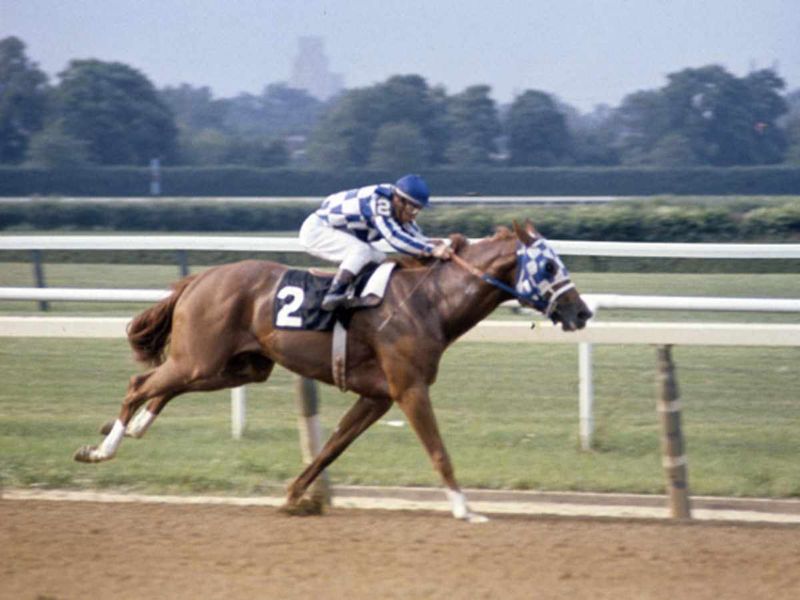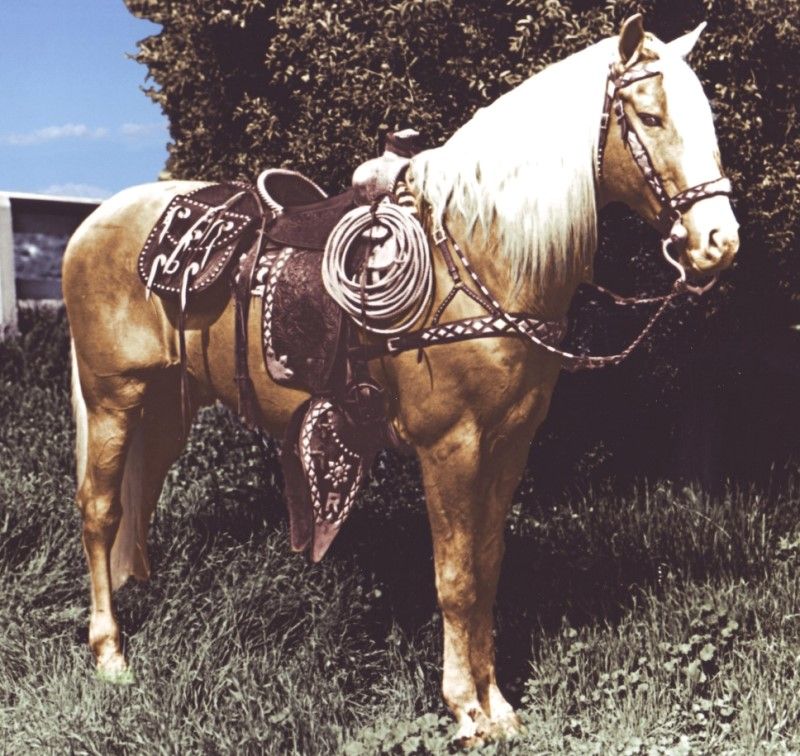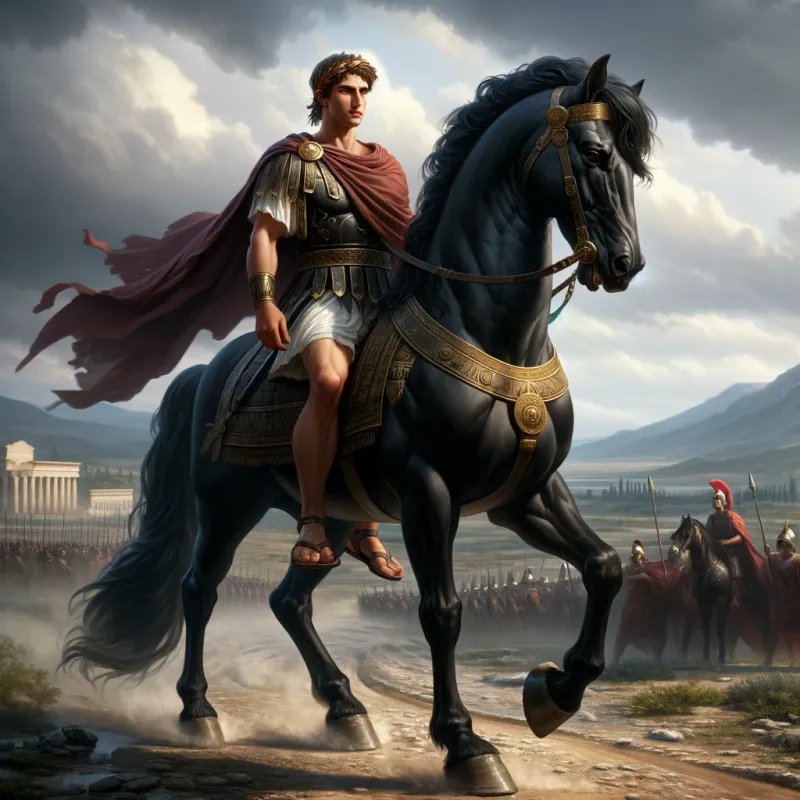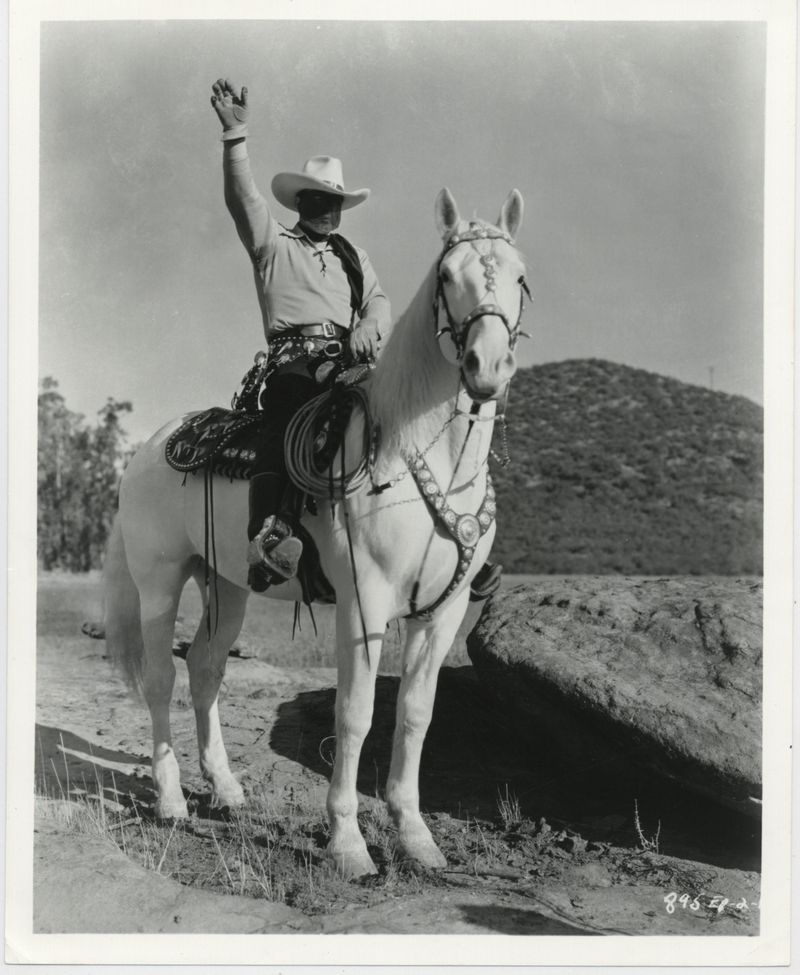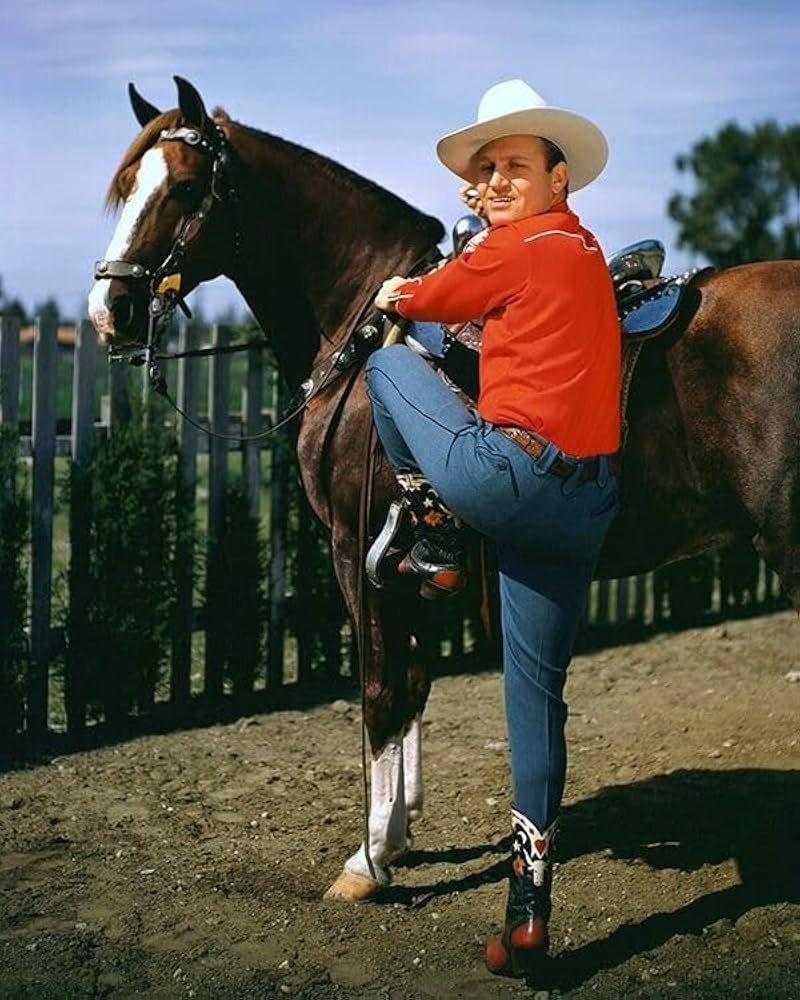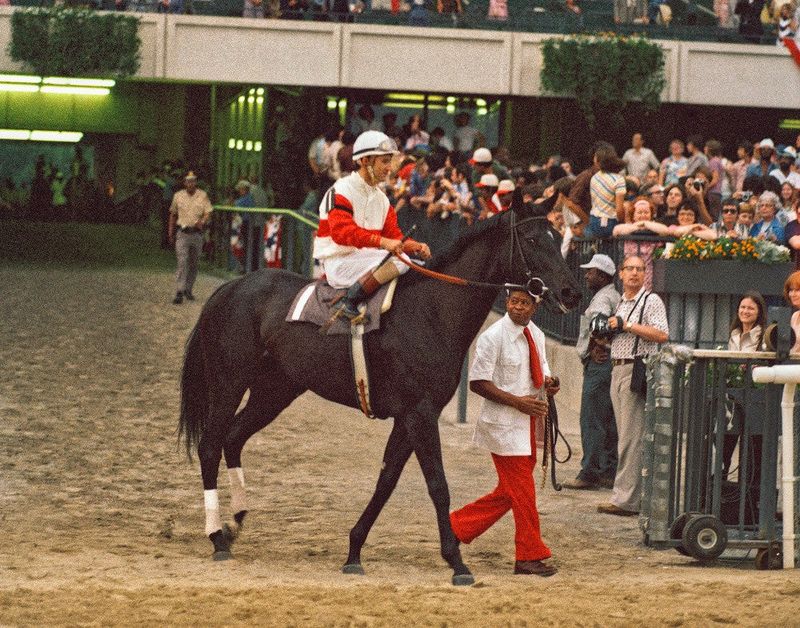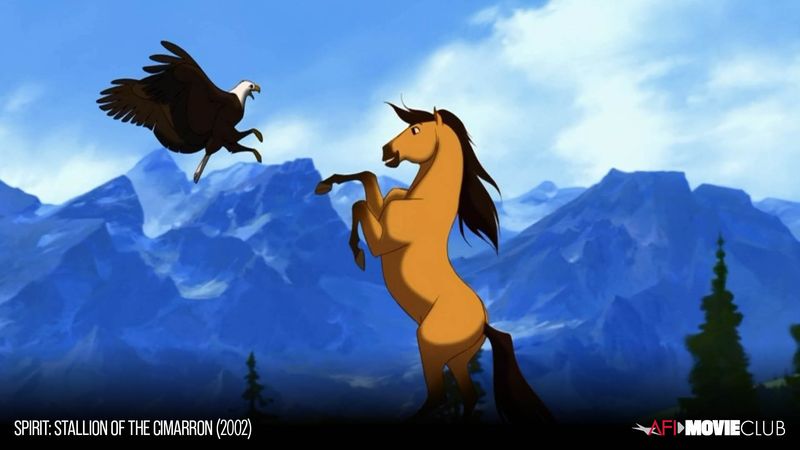Throughout history, certain extraordinary horses have galloped their way into our hearts, overshadowing even their accomplished riders. These magnificent animals captured public imagination through their speed, beauty, personality, or sheer star power. From racetrack legends to silver screen celebrities, these horses became household names while their human partners faded into the background.
1. Secretariat (1973 Triple Crown Winner)
The chestnut thoroughbred with three white socks dazzled America with superhuman speed. Secretariat didn’t just win races—he demolished them. His 31-length victory at the Belmont Stakes created a record that stands unbroken half a century later. Affectionately nicknamed “Big Red,” he appeared on the covers of Time, Newsweek, and Sports Illustrated in the same week. While jockey Ron Turcotte guided him masterfully, it was Secretariat’s massive heart (literally three times normal size) and charisma that made him a cultural phenomenon. Even today, racing fans speak his name with reverence, while few remember who rode him to glory.
2. Trigger (Roy Rogers’ Golden Palomino)
Golden coat gleaming under studio lights, Trigger performed tricks that left audiences gasping. This intelligent palomino could walk on his hind legs, untie knots, and even sign his own autographs with a hoof print. Appearing in over 150 films and television episodes, Trigger received more fan mail than Roy Rogers himself. Their partnership lasted 20 years, but it was always clear who the real star was. When Trigger died, Rogers couldn’t bear to bury him and had the horse preserved through taxidermy—a testament to how this equine celebrity transcended his status as merely a cowboy’s sidekick.
3. Black Beauty (Fictional but Iconic)
Born from Anna Sewell’s imagination in 1877, Black Beauty galloped straight into literary immortality. This fictional ebony horse narrated his own life story, revolutionizing how people viewed animal welfare and horse treatment. The novel has never been out of print and inspired countless film adaptations. Children worldwide shed tears over Beauty’s hardships and celebrated his triumphs, creating generations of horse lovers and animal advocates. While various characters ride and own Beauty throughout the novel, it’s his voice and perspective that readers remember—not the rotating cast of human handlers who come and go through his life.
4. Comanche (The Lone Survivor of Little Bighorn)
Bloody and wounded but still standing after the smoke cleared—Comanche became an instant American legend. Found barely alive on the battlefield where General Custer and his men fell, this cavalry mount defied death itself. The Army honored him as the sole survivor of the Battle of Little Bighorn, declaring no one would ever ride him again. Captain Myles Keogh, his rider, died in the infamous 1876 battle, but Comanche lived on as a symbol of resilience. For years afterward, this mustang-mix appeared in military ceremonies, standing at attention while draped in black, riderless tack—a four-legged hero who outlived his human companion.
5. Mr. Ed (The Talking TV Horse)
“Hello, I’m Mr. Ed!” Those words made television history when a palomino moved his lips and spoke directly to audiences. This equine comedian starred in his own sitcom from 1961 to 1966, delivering punchlines that had America in stitches. Actor Alan Young played straight man Wilbur Post, but everyone tuned in for the horse’s antics. Mr. Ed would only speak to Wilbur, creating comedic situations when the human tried explaining his talking horse to skeptical friends. The show’s theme song promised “A horse is a horse, of course, of course”—but Mr. Ed proved he was much more, becoming a cultural icon whose fame eclipsed his human co-stars.
6. Seabiscuit (The Underdog Champion)
Small, knobby-kneed, and initially dismissed as worthless—Seabiscuit transformed from racing reject to Depression-era hero. His legendary 1938 victory over Triple Crown winner War Admiral lifted the spirits of millions of struggling Americans who identified with his against-all-odds story. Jockey Red Pollard shared Seabiscuit’s underdog status, but it was the horse who captured America’s imagination. Radio broadcasts of his races drew larger audiences than presidential speeches. When Seabiscuit retired, newspapers across the country carried the announcement on their front pages—a level of fame no human jockey has ever achieved, proving this little horse with the big heart transcended sports to become a cultural phenomenon.
7. Bucephalus (Alexander the Great’s Legendary Steed)
Ancient historians tell us that when twelve-year-old Alexander tamed the untamable black stallion, his father King Philip II declared: “My son, seek a kingdom worthy of yourself, for Macedonia is too small for you.” Bucephalus became the most expensive horse in history, costing 13 talents—equivalent to millions in today’s currency. The massive warhorse carried Alexander through conquests spanning three continents. Legends claim Bucephalus had one blue eye and one brown, and would kneel to allow Alexander to mount. When the horse died in 326 BCE, Alexander founded an entire city in his honor—Bucephala—a tribute no human companion received from the great conqueror.
8. Silver (The Lone Ranger’s Trusty Steed)
“Hi-yo, Silver! Away!” That famous call announced the arrival of justice in the Old West, but audiences were often more enchanted by the magnificent white stallion than his masked rider. Standing 17 hands high (about 5’8″ at the shoulder), Silver’s gleaming coat and flowing mane created an unforgettable silhouette against desert skies. The Lone Ranger’s identity remained mysterious by design. Yet Silver was instantly recognizable, performing impossible feats of speed and intelligence that stretched believability. The horse could understand complex commands, untie knots, and somehow always knew when danger approached. Silver merchandise outsold Lone Ranger products, proving which character truly captured fans’ hearts.
9. Phar Lap (Australia’s Wonder Horse)
Standing over 17 hands tall with a massive heart weighing 14 pounds (twice normal size), Phar Lap dominated Australian racing during the Great Depression. This chestnut giant won 37 of 51 races despite carrying crushing weights assigned by handicappers trying to level the field. Ordinary Australians saw him as a symbol of hope during desperate times. His mysterious death in 1932 (likely from arsenic poisoning) plunged the nation into mourning. Jockey Jim Pike guided Phar Lap to many victories, but when Australia’s postal service issued commemorative stamps decades later, they featured only the horse—the ultimate recognition that while riders come and go, Phar Lap’s legend stands eternal in Australian identity.
10. Champion the Wonder Horse (Gene Autry’s Sidekick)
Performing without safety equipment or camera tricks, Champion amazed audiences with death-defying stunts that would terrify modern insurance companies. This talented palomino could slide down hills on his haunches, jump through windows, and dance on his hind legs to music. Actually a succession of horses (Champion, Champion Jr., and Champion III), these equine performers received separate screen credits from Gene Autry in films and television. Fan mail addressed simply to “Champion, Hollywood” would reach the studio without issue. While Autry sang cowboy tunes, Champion stole scenes with personality and athleticism that made him the true star of their partnership—the four-legged hero children rushed to theaters to see.
11. Ruffian (The Undefeated Filly)
Coal-black with a single white marking, Ruffian ran with such ferocity that other fillies couldn’t come within 15 lengths of her. This magnificent thoroughbred led every race of her career from start to finish—a feat unmatched in racing history. Sportscaster Jim McKay called her “the perfect horse, the perfect racehorse.” Her tragic breakdown during a 1975 match race against Kentucky Derby winner Foolish Pleasure became national news, with her death making front pages across America. Jockey Jacinto Vásquez rode many champions, including Kentucky Derby winners, but admitted years later: “She was the best horse I ever rode.” Ruffian was buried with her nose pointing toward the finish line she never reached.
12. Spirit (From Spirit: Stallion of the Cimarron)
Animated by DreamWorks but inspired by real wild mustangs, Spirit galloped into hearts worldwide with his fierce independence and refusal to be broken. Unlike most animated animals, he never spoke human words—communicating through realistic horse sounds and expressive animation. The 2002 film and subsequent Netflix series showcased the mustang’s journey through the American frontier, fighting for freedom. Spirit’s personality came through in his eyes and body language, creating an authentic horse character rather than a human in animal form. Matt Damon narrated Spirit’s thoughts in the original film, but the character’s popularity stemmed from his visual expressiveness and untamable nature—a celebration of wildness that resonated with audiences of all ages.

